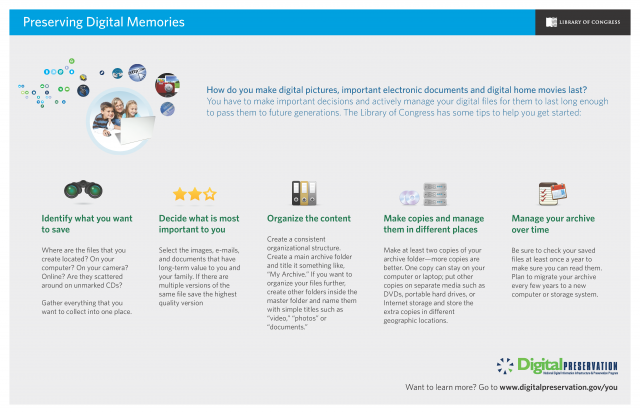
In today’s digital age, photos, videos, and other records are digital. In the past, we worried about paper photographs and home movie films fading over time. But today, the biggest threat is losing the digital bits and bytes that make up these precious files.
My previous article “Preserving Electronic Family History Information” provided ideas on how to organize and back up your information. This article provides more in-depth steps to consider in preserving your digital treasures.
Preservation isn’t a one-time process. The Library of Congress provides some tips to actively manage your digital pictures, important electronic documents, and digital home movies. The site DigitalPreservation.gov/you provides a lot of good information on how to preserve your digital memories.
Below are some additional ideas:
Identify what you want to save
Where are your files located? On your computer? On your camera? Online? Are they scattered around on unmarked CDs? Gather everything that you want to collect into one place.
Items you may want to consider saving could include the following list from the Digital Preservation Coalition: email and letters, websites and blogs, diaries, recipes, drawings and other art, photographs and photo albums, music, video, voice recordings, social media posts, text messages, instant messages, contact lists, calendars, spreadsheets, presentations, databases, personal records (bank statements, bills, taxes, home inspection reports, deeds), medical records, and mementos (digitized versions of physical items).
Decide what is most important to you
Select the images, emails, and documents that have long-term value to you and your family. If there are multiple versions of the same file, save the highest quality version.
The Digital Preservation Coalition suggests that you ask yourself these questions:
- Which files would you miss most if they suddenly disappeared?
- What qualities about those files are most important? For example, does it matter if the formatting of a word-processing document changes if the text is still readable?
- Do your digital photos include important descriptive or contextual information that you need to use a particular program to see?
Organize the content
- Create a consistent organizational structure of folders and subfolders that make sense for the content you want to save.
- Find the files are on your computer, external hard drives, CDs, DVDs, floppies, etc.
- Copy all the files you want to keep on one hard drive, if possible, and create a logical folder structure to help you locate files in the future.
Make copies and manage them in different places
- Make two or more copies of your archive folder. One copy can stay on your computer or laptop and put other copies on separate media such as DVDs, portable hard drives, or cloud storage and store them in different geographic locations. (If your house burned down, you don’t want to lose everything. So give a copy to a relative that doesn’t live with you.)
Manage your archive over time
- Review the files periodically to make sure they still open. If not, make replacement copies of corrupt files saved in other locations.
- Migrate your archive every few years to a new computer or storage system.
The Digital Preservation Coalition states that “technological obsolescence and lack of planning are two of the most obvious threats to the wellbeing of personal digital files, but less visible threats can be equally harmful.” Most risks to digital files fall into the following categories:
- Ageing hardware and software
- Lack of secure storage and backup
- Natural and manmade disasters
- Neglect
- Loss of cloud-based host or service provider
- Lack of planning
- Death of an individual
Recommendations from the Digital Preservation Coalition:
- Choose software that is well supported and that creates files that can be read by a variety of different programs.
- Develop file naming conventions that are easy to remember and apply these consistently.
- Create multiple back-up copies and store them in different geographical locations.
- Test your back-up copies to make sure they are accessible and contain what you intend them to.
- Transfer files to new media every 2 to 4 years.
- Determine what you want to happen to your digital files in the event that you are incapacitated or die.
- Document your wishes in whatever way makes the most sense to you. Share that documentation with people you trust.
- Choose high-quality storage media and refresh it regularly.
- Be proactive about refreshing storage media, replacing outdated equipment before it fails, and not relying exclusively on one service provider or storage solution.
